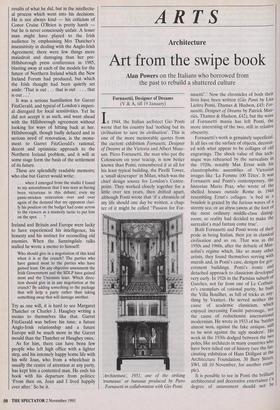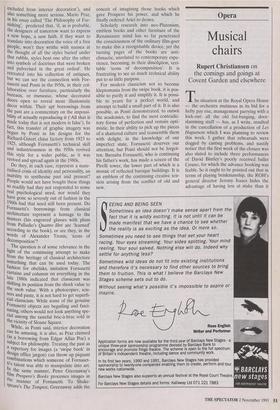ARTS
Architecture
Art from the swipe book
Fornasetti, Designer of Dreams (V & A, till 19 January)
In 1944, the Italian architect Gio Ponti wrote that his country had 'nothing but its civilisation to save its civilisation'. This is one of the more memorable quotes from the current exhibition Fomasetti, Designer of Dreams at the Victoria and Albert Muse- um. Piero Fornasetti, the man who put the Colosseum on your teacup, is now better known than Ponti, remembered if at all for his least typical building, the Pirelli Tower, a 'small skyscraper' in Milan, which was the chief design source for London's Centre- point. They worked closely together for a little over ten years, then drifted apart, although Ponti wrote that 'if a chronicle of my life should one day be written, a chap- ter of it might be called "Passion for For-
Architettura', 1951, one of the striking `trumeaux' or bureaux produced by Piero Fornasetti in collaboration with Gio Pond
nasetti".' Now the chronicles of both their lives have been written (Gio Ponti by Lisa Licitra Ponti, Thames & Hudson, £45; Far- nasetti, Designer of Dreams by Patrick Mau- ries, Thames & Hudson, £42), but the wave of Fornasetti mania has left Ponti, the more interesting of the two, still in relative obscurity. Fornasetti's work is genuinely superficial. It all lies on the surface of objects, decorat- ed with what appear to be collages of old engravings. The shock value of this tech- nique was rehearsed by the surrealists in the 1920s, notably Max Ernst with his claustrophobic assemblies of • Victorian images like 'La Femme 100 Tates'. It was Fornasetti and Ponti's contemporary, the historian Mario Praz, who wrote of the shelled houses outside Rome in 1944 resembling Ernst's collages: 'a bed in a boudoir is grazed by the furious waves of a stormy sea; or an abyss yawns at the foot of the most ordinary middle-class dining- room; so reality had decided to make the surrealist's mad fantasy come true'. Both Fornasetti and Ponti wrote of their pride in being Italian, their joy in classical civilisation and so on. That was in the 1950s and 1960s, after the debacle of Mus- solini's regime which, like so many other artists, they found themselves serving with murals and, in Ponti's case, designs for gov- ernment buildings. Ponti's ironic and detached approach to classicism developed very early. In 1926 in the Parisian suburb of Garches, not far from one of Le Corbusi- er's exemplars of rational purity, he built the Villa Bouilhet, as full of tricks as anr thing by Venturi. He served neither the cause of academic classicism, which enjoyed increasing Fascist patronage, nor the cause of reductionist international modernism. He wrote in 1933 of his 'battles almost won, against the fake antique, still to be won against the ugly modern'. Hls work in the 1930s dodged between the tw° poles, like architects in many countries wh° have been tidied out of history (see the fas' cinating exhibition of Hans Dollgast at the Architecture Foundation, 30 Bury Street, SW1, till 10 November, for another exam- ple). It is possible to see in Ponti the brillian, t architectural and decorative entertainer ( degree of amusement should not be excluded from interior decoration'), and also something more serious. Mario Praz, in his essay called 'The Philosophy of Fur- nishing', predicted that, if, as is probable, the designers of tomorrow want to express a new hope, a new faith, if they want to translate into decoration the voice of a free People, won't they writhe with nausea at the thought of all the styles buried under that rubble, styles bent one after the other into symbols of doctrines that were broken and pulverised in the great ordeal'. He retreated into his collection of antiques, but we can see the connection with For- nasetti and Ponti in the 1950s, in their col- laboration over furniture, particularly the bureaux, or tntmeaux, whose decorated doors open to reveal more illusionistic decor within. Their apt borrowings from the past are a commentary on the impossi- bility of actually reproducing it ('All that is made today that is not modern is false'). In fact, this transfer of graphic imagery was begun by Ponti in his designs for the Richard-Ginori china factory from 1923 to 1925, although Fornasetti's technical skill and industriousness in the 1950s revived this style for a wider public, as it was revived and spread again in the 1980s. Do they, in each case, represent a mate- rialised crisis of identity and personality, an inability to synthesise past and present? People would not have bought these things SO readily had they not responded to some real psychological need, nor would they have gone so severely out of fashion in the 1960s had that need still been present. Do Pornasetti's borrowings from classical architecture represent a homage to the masters (his engraved glasses with plans from Palladio's Quattro libri are 'learned' according to the book), or are they, in the words of Alexander Tzonis, 'icons of decomposition'?
The question is of some relevance in the light of the continuing attempt to make from the heritage of classical architecture something that can be used today. The fashion for obelisks, imitation Fornasetti curtains and columns on everything in the late 1980s indicated that classicism was Shifting its position from the shock value to the snob value. With a photocopier, scis-
rs and paste, it is not hard to get superfi- cial classicism. While some of the genuine Pornasetti objects are beguiling and fasci- nating, others would not look anything spe- cial among the tasteful bric-à-brac sold in the vicinity of Sloane Square.
While, as Ponti said, interior decoration
n be amusing, it is also, as Praz claimed On a borrowing from Edgar Allan Poe) a subject for philosophy. Treating the past as a repertory for images (a 'swipe book' in design office jargon) can throw up piquant ee., mbinations which someone of Fornaset- ti s talent was able to manipulate into art. In the same manner, Peter Greenaway's nhn Prospero's Books processes images in the manner of Fornasetti. To Shake- sPeare's The Tempest, Greenaway adds the
conceit of imagining those books which gave Prospero his power, and which he finally ordered Ariel to drown.
Scholarly research into neo-Platonism, emblem books and other furniture of the Renaissance mind has so far penetrated the consciousness of the ordinary film-goer to make this a recognisable device, yet the turning pages of the books are anti- climactic, unrelated to contemporary expe- rience, becoming, in their dissolution, veri- table 'icons of decomposition'. It is frustrating to see so much technical ability put to so little purpose. For modern classicism not to become kleptomania from the swipe book, it is pos- sible to purify it and simplify it. It is possi- ble to yearn for a perfect world, and attempt to build a small part of it. It is also possible, as Ponti demonstrated, to outwit the academics, to find the most contradic- tory forms of perfection and remain opti- mistic. In their ability to pick up the pieces of a shattered culture and reassemble them with delight, in the knowledge of our imperfect state, Fornasetti deserves our attention, but Ponti should not be forgot- ten. Barnaba Fornasetti, who is continuing his father's work, has made a screen of the Pirelli tower, the lower part of which is a mosaic of reflected baroque buildings. It is an emblem of the continuing creative ten- sion arising from the conflict of old and new.



































































 Previous page
Previous page